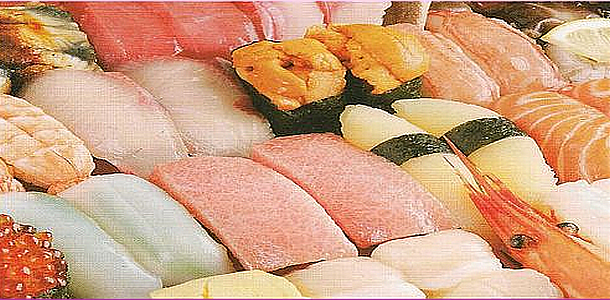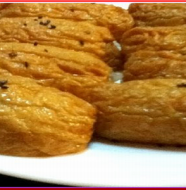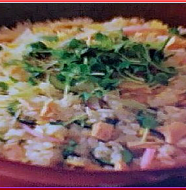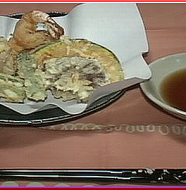Here’s a three part series list of Nigiri Sushi you will find in most Sushi Restaurants and Sushi bars. In these first series I will list what you will most likely to find in most Sushi Restaurants and Sushi Bars. The list that I have made is based in Japan Restaurants and Bars. You may have check of your local Sushi Restaurant to see if they have the same or something similar. In Japan we have a lot of seafood that may no be available in your area.
I really love Sushi, but we don’t go to the restaurants as much now as before. Maybe due to the price of fresh now days here in Japan are getting more and more expensive. So we probably go to our favorite Sushi Bar once every two months or so.
So let’s get going with the Nigiri Sushi List:
- Tamago (Sweeten Egg): This a Japanese fired rolled egg cut and placed on top of the rice with a thin strip of nori(Seaweed) wrapped. It also comes with or with wasabi(Horse Radish)*.
- Sake (Salmon): This is a fresh salmon sliced into month sushi size and placed on top of the sushi rice. This also comes with or without wasabi(Horse Radish)*.
- Maguro (Tuna): This is a fresh tuna sliced into mouth sushi size and placed on top of the sushi rice. This also comes with or without wasabi(Horse Radish)*. The Maguro has 3 different type of levels, which I will example at the end of this list.
- Hamachi (Yellow-Tail) : This is a fresh yellow tail sliced into mouth size and placed on top of the sushi rice. This also comes with or without wasabi(Horse Radish)*.
- Ebi (Shrimp): This is a freshly shrimp cut in half and placed on top of the sushi rice. This also comes with or without wasabi(Horse Radish)*.
- Anago (Sea Eel): This is Sea Eel which is either used freshly or cooked over a fire, than cut into mouth size and placed on top of the sushi rice. This also comes with or without wasabi(Horse Radish)*.
- Unagi (Fresh Water Eel): This is a Fresh water eel that is either boiled or cooked over a fire, than cut into mouth size and placed on top of the sushi rice. This also comes with or without wasabi(Horse Radish)*.
- Tako (Octopus): This is an Octopus which is either boiled or served freshly, cut into mouth size and placed on top of the sushi rice. This also comes with or without wasabi (Horse Radish)*.
- Ika (Squid): This is a Squid which is freshly used, cut into mouth size and place on top of the sushi rice. This also comes with or without wasabi(Horse Radish)*.
- Hokki Gai (Surf Calm): This is a Calm which is freshly used, cut in half and placed on top of the sushi rice. This also comes with or without wasabi(Horse Radish)*.
- Saba (Mackerel): This is a Mackerel used freshly, cut into mouth size and placed on top of the sushi rice. This also comes with or without wasabi(Horse Radish)*.
- Amaebi (Sweet Shrimp): This is a Shrimp that is freshly used and placed on the sushi rice. This also comes with or without wasabi(Horse Radish)*.
- Ikura (Salmon Roe): This is Salmon Roe freshly used and placed on top of the sushi rice, wrapped with a thin layer of nori(Seaweed) around the sushi rice.
- Uni (Sea Urchin): This is a freshly used urchin which is placed on top of the sushi rice and wrapped with a thin layer of nori(Seaweed) around the sushi rice.
- Kani (Crab): This is Freshly used crab, cut into mouth size and place on top of the sushi rice. This also comes with or without wasabi(Horse Radish)*.
- Kurodai (Sea Bass): This is a freshly used Sea Bass, cut into mouth size and placed on top of the sushi rice. This also comes with or without wasabi(Horse Radish)*.
- Tobiko (Flying Fish Roe): This is a freshly used Flying Fish Roe and is placed on top of the sushi rice, wrapped with a thin layer of nori(Seaweed) around the sushi.
Here is a small explanation on the Maguro Sushi. There are many types of Maguro Fish(Tuna) we use here in Japan. Here are three type of Maguro Sushi:
- Akami: Is not oil and doesn’t have much fat. Which you will find in most restaurant outside of Japan.
- Chutoro: Is in between Akami and Ohtoro Maguro, it has a little of both oil and fat. This one of mines and the kids favorites.
- Ohtoro: Is a very oil and fat Maguro sushi. This can be very expensive depending on the Sushi Restaurant or Sushi Bar.
There is my list of most common Nigiri Sushi you may find in your Local Sushi Restaurants or Sushi Bars. In the next series of Nigiri Sushi, I will have a list of Sushi you may or may not find in your Sushi Restaurants or Sushi Bars.
I hope you enjoy this part one of three, Nigiri Sushi. Feel free to leave me any questions, I will be glad to answer them for you. See you in the next part, have a great day.
* Note: This is optional you can have it with or without wasabi, it depends on the restaurant.

















You have given a nice list of most common Nigiri Sushi List..Its really very interesting to read this list.Some of these Sushis are new for me as I did not know about it before.I like that you have given description for all.
It looks delicious, but in the same time I am afraid of eating crude fish, it can contain infections, it isn’t healthy.
Sandra you are right but still sushi is a traditional meal which also is very useful for a female organism.
IMHO sushi is probably the best food in the world, especially when it is served with a right souse, and not with ketchup as Americans loves.
I have heard that there are 2 types of sushi: sushi rice and sushi roll and what’s the difference between them?
I have heard that Tamago sushi is also called sushi Omelette could you give a detailed recipe.
Is it true that not all sushi should be rolled, my coworker is an ex cook and he told me that sushi is just fish with some species.
Thank you for this list of common Nigiri Sushi that we may find in our Local Sushi Restaurants or Sushi Bars now I’ll know what to choose.
I feel so ashamed that I’ve tasted only one type of Sushi when there are more than a dozen, I wish I was in Japan.
I love Nigiri Sushi, can you make some video lessons on how to prepare them, cause reading is one thing, but watching is another.
I think that the biggest problem in preparing sushi is finding the right type of fish, cause it’s a bit problematic here in Europe.
Nigiri sushi puts everything in full sight for you: It’s your selected protein on rice with a touch of wasabi between the two.
Is it true that you can get intoxicated from Sushi? My brother told me a case when a person went to comma after eating them.
Yammy thank you for the description of Nigiri sushi, I’ll try making them, I hope I’ll manage.
It’s been long time since I ate sushi, unfortunately it’s not so easy to find a sushi bar here in Alaska you have to go to Anchorage to buy it.
Just recently I found out that sushi does not mean raw seafood; instead, it refers to the vinegared rice that can be paired with raw seafood. So even vegetarians and those determined on having their meals cooked can be satisfied by sushi.
I’ve heard that Sushi can be classified as a health food, being low in fat and calories while high in protein. Seaweed is extremely high in vitamins A, B1, B2, B6, C and niacin.
i once bought sushi in australia, it was reaaally delicious, but here in holland it tasted like crap :/
The general rule that I’ve found for coming up with dishes using sashimi is that if there is a sauce or marinade or glaze that works well with a cooked version of the fish, then some play on that sauce will most likely go great with the sashimi version of the fish.
I wonder if it is possible to add horseradish to nigiri sushi, and if it still will be comestible.
Nigiri sushi nearly means “hand rolled” sushi. Instead of the ingredients being inside of the nori (seaweed), one piece is usually draped over a small ball of rice; sometimes having a small strip of nori around the fish/item to keep it secured on the rice.
Thankfully sushi is not a particularly fattening food, and a low calorie meal is not out of the cards if you have a craving for sushi. While rice contains a fair amount of carbohydrates, sushi can be eaten without it (as sashimi) and in moderation, even a standard sushi item can be a healthful treat without breaking the calorie bank.
Yammy, there is nothing compared with a proper prepared Nigiri Sushi, I love it, plus it is very healthy.
Nigiri is a kind of sushi made with vinegared sushi rice (shari), and a slices of fish, seafood, or vegetable. Nigiri sushi is easier to make than maki, or uramaki sushi, and some would say even easier to consume
Is it true that in Nigiri Sushi eggs are used? I’m asking cause I found a recipe where eggs where mentioned.
A cock once said that when using fish loins or fillets, look closely and remove any bones with fish tweezers or kitchen pliers. Normally with salmon fillets it’s possible to cut fish into a block shape about 1 to 1 1/2 inches thick, 3 1/2 wide and 4 to 5 inches long, as in the salmon photo. This size block is easy to slice.
Nigiri sushi is easy to make by hand, as molding a little rectangle-shaped mound of rice isn’t that hard. Just be sure to wet your hands to keep the rice from sticking to you. I use a mold purely for convenience (and because I bought the darn thing, so I should use it!).
Nigiri sushi is probably the best sushi you can find in US, maybe because it is easy to prepare, but it is delicious.
Osaka-style sushi, squares of pressed rice topped with vinegared or cooked fish. The sushi is prepared in a wooden box called an oshiwaku, then unmolded and cut into bite-size squares and rectangles. There are different styles of pressed sushi, including battera (topped with mackerel or gizzard shad and cut into squares or rectangles), bozushi (pressed into a long candy bar shape and cut into bite-size pieces), hazushi (layered with plant leaves), hakozushi (cut into squares or rectangles, Osaka style), masuzushi (utilizing a bamboo leaf) and tazunazushi (toppings put on at a slant, resulting in “candy cane” stripes).
I’ve heard that Nigiri requires using big shrimps. Usually shrimps come in a frozen bag, raw or boiled. Raw shrimps are covered in greenish shell and boiled shrimps are white with red spine.
Nigiri is a kind of sushi made with vinegared sushi rice (shari), and a slices of fish, seafood, or vegetable. Nigiri sushi is easier to make than maki, or uramaki sushi, and some would say even easier to consume
The general rule that I have found for coming up with dishes using sashimi is that if there is a sauce or marinade or glaze that works well with a cooked version of the fish, then some play on that sauce will most likely go great with the sashimi version of the fish.
Thank you for this list of common Nigiri Sushi that we may find in our Local Sushi Restaurants or Sushi Bars now I’ll know what to choose.
Otoro sushi is indeed very expensive due to its taste and texture but more for its scarcity. They say it is the fattiest part of the tuna fish. I treated myself to this and ‘twas a great indulging experience. You just have to try it. Akami is less exotic though in my own opinion because it’s common but its less fatty so this is good for those who are watching their diet.
Thanks for the post, I’m not that familiar with Japanese foods. And because of your post, I’ll certainly learn more about it.
I’ll sure be going back for more on your site.
Thanks. God Bless.